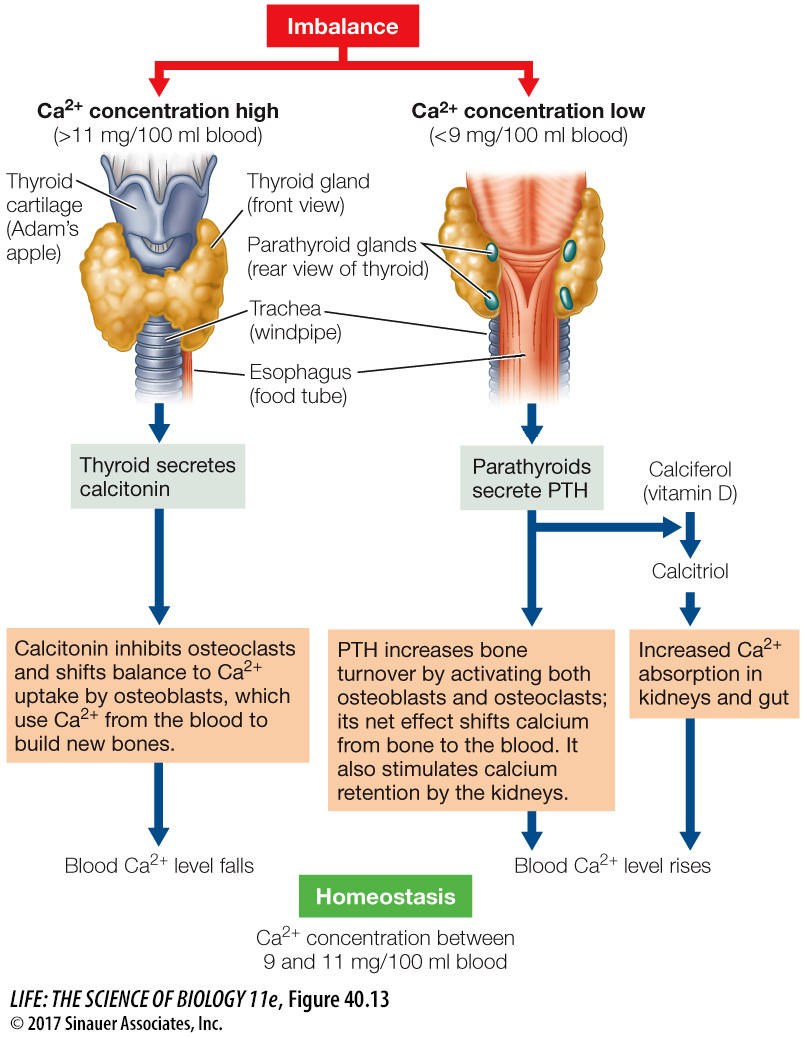Three hormones regulate blood calcium concentrations
The regulation of calcium concentration in the blood is crucial, and shifts in blood calcium concentration above or below a narrow range can cause serious problems. When blood calcium falls below this range, the nervous system becomes overly excited, resulting in muscle spasms and even seizures. When blood calcium rises above this range, the nervous system becomes depressed and muscles—
The body has multiple mechanisms for changing blood calcium levels, including:
Deposition or absorption of bone
Excretion or retention of calcium by the kidneys
Absorption of calcium from the digestive tract
These mechanisms are controlled by three hormones: calcitonin, parathyroid hormone, and calcitriol (synthesized from vitamin D).
Animation 40.3 Hormonal Regulation of Calcium
CALCITONIN REDUCES BLOOD CALCIUM Calcitonin is released by the thyroid and lowers the concentration of calcium in the blood, mainly by regulating bone turnover (Figure 40.13). Bone is continuously remodeled through a dynamic process that involves both resorption of old bone and synthesis of new bone, as we will discuss in Key Concept 47.3. Cells called osteoclasts break down bone and release calcium into the blood, and cells called osteoblasts take up calcium from the blood and deposit it in new bone. Calcitonin decreases the activity of osteoclasts and thereby favors removal of calcium from the blood and its deposition in bone by osteoblasts. The turnover of bone in adult humans is not very high, so calcitonin does not play a major role in calcium homeostasis in adults. It is probably more important in young individuals whose bones are actively growing.

PARATHYROID HORMONE INCREASES BLOOD CALCIUM The parathyroid glands are four tiny structures embedded in the posterior surface of the thyroid gland (see Figure 40.13). Their single hormone product, parathyroid hormone (PTH, also called parathormone), is the most important hormone in the regulation of blood calcium levels. Circulating calcium activates receptors in the cell membrane of the parathyroid cells. When these receptors are active, they inhibit the synthesis and release of PTH. A fall in blood calcium removes this inhibition and triggers the synthesis and release of PTH. PTH stimulates bone turnover by actions on both osteoclasts and osteoblasts. The end result of these actions of PTH is a net increase of calcium in the blood. PTH also maintains blood concentration of calcium by stimulating the kidneys to reabsorb it rather than excrete it in the urine.
CALCITRIOL INCREASES BLOOD CALCIUM It had long been known that fragile bones were common among people living at high latitudes, where winter days are short and the winter diet often lacks fish, dairy products, and fresh vegetables. Since the condition could be reversed by taking cod-
A vitamin is a substance that the body requires in small quantities but cannot synthesize for itself and must therefore obtain from food (or from supplements such as vitamin pills). However, vitamin D—